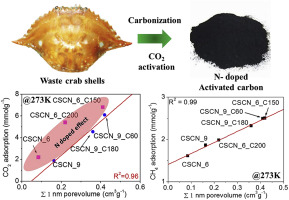Microporous and Mesoporous Materials ( IF 4.8 ) Pub Date : 2018-06-15 , DOI: 10.1016/j.micromeso.2018.06.021 Hee Soo Kim , Min Seok Kang , Seunghun Lee , Yong-Woo Lee , Won Cheol Yoo

|
Highly N-doped crab shell-derived carbon nanofibers (CSCNs) with enhanced sorption capacity for CO2 and CH4 are presented. Two different carbonization temperatures, 600 °C and 900 °C were utilized to control the N-doping level of the CSCNs; the N-content of CSCN processed at 600 °C is higher than that processed at 900 °C. After judicious activation process to fine-tune ultramicroporosity (<1 nm) by hot CO2 treatment, the CSCN obtained from 600 °C with the most developed ultramicroporosity showed higher CO2 uptake capacity compared to that of CSCN carbonized at 900 °C due to higher N-doping level, although the ultramicroporosity of the two samples is similar. In contrast, similar CH4 sorption capacities were identified for these samples. In addition, very efficient and selective separation of CO2/N2 was achieved from CSCN carbonized at 600 °C with maximum ultramicroporosity; meanwhile, similar selective separations of CH4/N2 were observed for both of the most activated CSCNs. As a result, the relationship between the ultramicroporosity and CO2 and CH4 uptake capacities, and N-doping effect are clearly elucidated.
中文翻译:

N掺杂和超微孔控制的蟹壳衍生碳可增强CO 2和CH 4的吸附
提出了高N掺杂的蟹壳来源的碳纳米纤维(CSCN),具有增强的CO 2和CH 4吸附能力。两种不同的碳化温度分别为600°C和900°C,以控制CSCN的N掺杂水平。在600°C下处理的CSCN的N含量高于在900°C下处理的CSCN的N含量。经过明智的活化过程以通过热CO 2处理微调超微孔(<1 nm),与在900°C碳化的CSCN相比,从600°C获得的具有超微孔最发达的CSCN具有更高的CO 2吸收能力。尽管两个样品的超微孔率相似,但N掺杂水平较高。相反,类似的CH 4确定了这些样品的吸附能力。另外,在最大超微孔率下,从在600°C下碳化的CSCN中,可以非常有效地选择性分离出CO 2 / N 2。同时,对于两个活化最强的CSCN,观察到相似的CH 4 / N 2选择性分离。结果,清楚地阐明了超微孔度与CO 2和CH 4吸收能力以及N掺杂效应之间的关系。











































 京公网安备 11010802027423号
京公网安备 11010802027423号